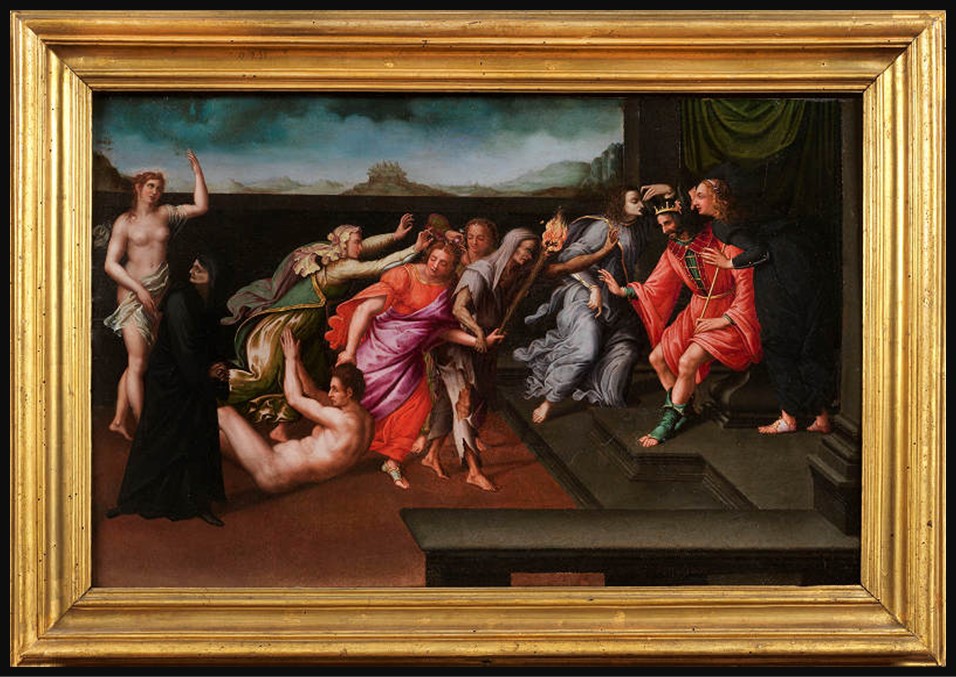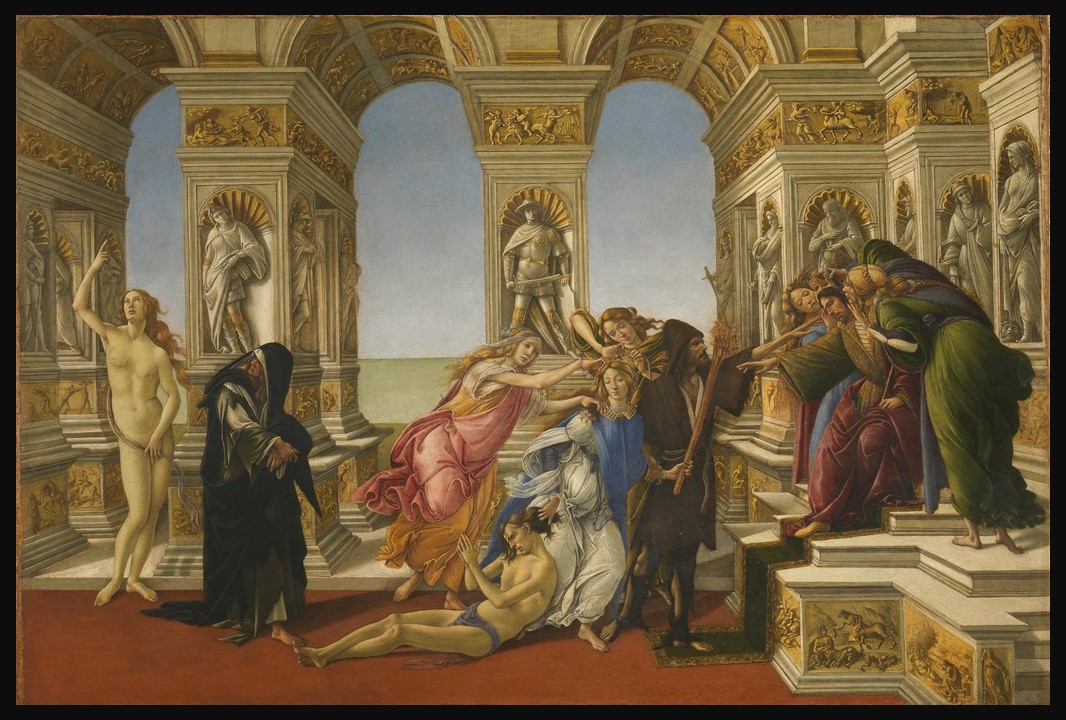
Allegory of Calumny, c. 1530, Oil on Canvas, Galleria Colonna, Rome Italy https://www.galleriacolonna.it/en/botticelli-and-his-workshop-allegory-of-the-calumny-on-temporary-loan-from-12-01-2023-to-04-14-2024-acropolis-museum-athens-exhibition-personifications-and-allegories/
In a world where misinformation can spread with the click of a button, the echoes of truth and deceit battle in the court of public opinion. This timeless struggle was vividly captured in the brushstrokes of The Allegory of Calumny, an intriguing 16th-century painting attributed to ‘Botticelli’s’ Workshop. Displayed as part of the exhibition titled ‘ΝοΗΜΑΤΑ’: Personifications and Allegories from Antiquity to Today at the Acropolis Museum, this Renaissance masterwork travelled from the Galleria Colonna in Rome to Greece, offering a unique opportunity to explore the multifaceted world of allegorical art.
Rising above the primary notion of the image, an allegorical painting seeks to uncover hidden, deeper meanings, visualizing abstract concepts with the aspiration of yielding educational outcomes. In this context, allegory emerges as a powerful form of expression that succeeds in cloaking the true meaning, engaging both written words and visual arts in a delicate dance of revelation and concealment. The Allegory of Calumny painting stands out as one of the most instructive examples from antiquity and the Renaissance, embodying the intricate layers of meaning that such symbolic representation can convey. To understand the painting, we first need to travel back to the 4th century BC and seek information on a lost painting by Apelles, then explore the Renaissance painting Calumny of Apelles by Sandro Botticelli, and finally discuss the painting in the Collection of Galleria Colonna in Rome.
The story of the painting Calumny by the legendary 4th century BC ancient Greek artist Apelles, as recounted by the writer Lucian (Luciano di Samosata, 2nd century BC), is a fascinating narrative that has inspired artists and thinkers through the ages. In Lucian’s telling, the celebrated Greek painter Apelles crafted the painting Calumny after becoming the victim of slander himself. The allegorical painting illustrated a tale of injustice and deception, where a blameless man was falsely accused by Calumny (Slander), personified as a beautiful but deceitful woman. Flanked by Malice, and Deceit, and led by Evil, Slander was depicted taking the innocent man before a judge, who was depicted with donkey’s ears, symbolizing his foolishness and inability to discern the truth. Beside the judge stood his advisors, Ignorance and Assumption. Apelles’ work served not only as a personal reflection on his experiences with slander but also as a universal commentary on the nature of truth, justice, and the destructive power of false accusations. Through this allegory, Apelles conveyed a poignant message about the ease with which innocence can be marred by malevolence, a theme that resonates as deeply today as it did in antiquity. http://lucianofsamosata.info/wiki/doku.php?id=home:texts_and_library:essays:slander

Calumny of Apelles, c. 1495, Tempera on Wood, 62×91 cm, The Uffizi, Florence, Italy https://www.uffizi.it/en/artworks/calumny-botticelli
Next, the journey through the Allegory of Calumny takes us into the heart of the Renaissance. It is here that Sandro Botticelli, drawing inspiration from ancient texts that describe Apelles’ work, reimagines this timeless theme through the lens of 15th-century Florence. Botticelli’s Calumny of Apelles not only pays homage to the original masterpiece but also enriches it with the nuanced intricacies of Renaissance artistry and thought, inviting us to explore how the allegorical message has been transformed and recontextualized for a new era. Crafted around 1495, this painting emerges at a pivotal moment, marking the transition from the flourishing Laurentian era to the dawn of a Republic under the influence of Girolamo Savonarola. This piece stands as Botticelli’s final foray into the realm of allegorical and mythological themes, showcasing his unparalleled ability to weave intricate narratives and interpret complex ideas through his art.
According to Giorgio Vasari, Botticelli’s painting was a gift to the artist’s friend Antonio Segni, with the following lines of his own composition beneath it: Indicio quemquam ne falso laedere tentent Terrarum reges, parva tabella monet. Huic similem Aegypti regi donavit Apelles Rex fuit et dignus munere, munus eo… Let any kings of the earth beware of attempting to harm anyone falsely; a small tablet warns them. Apelles, the painter, gave a similar one to the king of Egypt; he was both a king deserving of the gift, and the gift was deserving of him. http://www.artist-biography.info/artist/sandro_botticelli/ and https://www.uffizi.it/en/artworks/calumny-botticelli
Having traversed the historical and artistic landscapes shaped by Apelles’ ancient masterpiece and Botticelli’s Renaissance reinterpretation, our exploration leads us to a final piece: The Allegory of Calumny, created by ‘Botticelli’s’ Workshop and residing in the prestigious Galleria Colonna in Rome. This rendition, exhibited, currently, in the Acropolis Museum in Athens and crafted by an artist whose name has eluded history, embodies the aesthetic values of harmony, proportion, and beauty that defined the period. With a delicate and polished use of line and colour, the unknown artist skillfully captures the viewer’s attention, guiding it across an intricate narrative tableau. The painting, lucking Botticelli’s extravagant architectural ‘fantasy’, depicts the allegorical figures with grace and emotional depth, weaving a rich tapestry of human drama that invites the observer to delve into its complex layers. Furthermore, reaffirms the themes and aesthetic principles of its predecessors, serving as a vivid testament to the enduring legacy of the Calumny motif. It invites us to appreciate the nuanced layers of interpretation and craftsmanship that span centuries, from classical antiquity, through the Renaissance, and into the heart of Italy’s artistic heritage.
For a Student Activity, inspired by the Allegory of Columny painting, please… Check HERE!